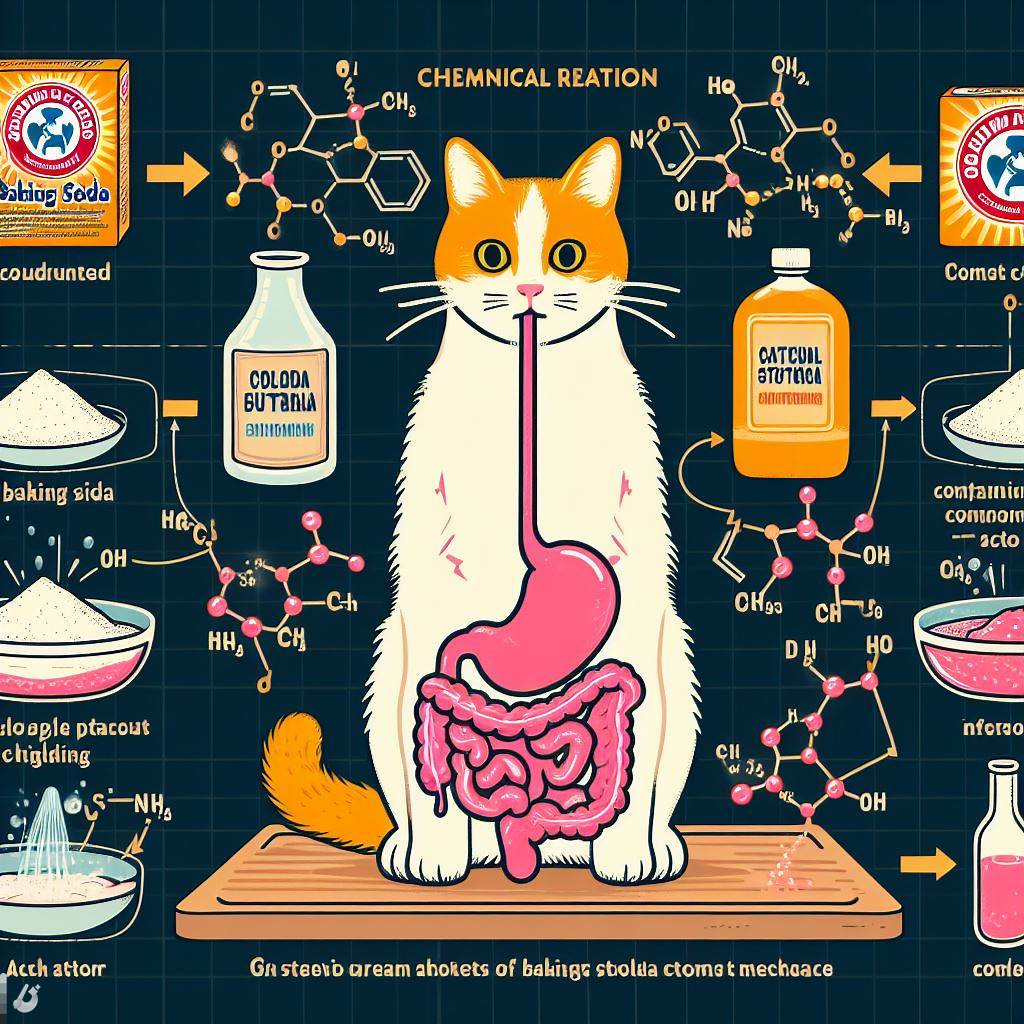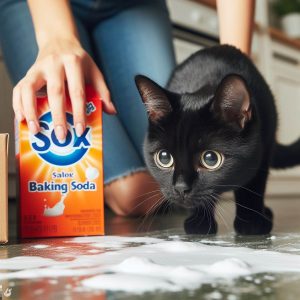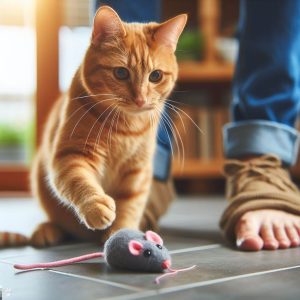As cat owners, we go to great lengths to cat-proof our homes. But one common chemical may fly under the radar – innocent-looking baking soda. While it has household uses, is this pantry staple actually safe for cats?
Baking soda and cats can be a risky combination if not handled properly. In this exhaustive guide, learn the science behind baking soda’s effects, expert safety tips, signs of toxicity, cat-friendly alternatives, and everything else to use it safely around felines.
How Does Baking Soda Work? The Science Behind Sodium Bicarbonate
To understand baking soda’s effects on cats, let’s first look at what it is on a chemical level.
Baking soda is the common name for sodium bicarbonate (NaHCO3), a water-soluble white powder. It’s comprised of sodium ions bonded with bicarbonate ions.
As a base substance, baking soda reacts with acids to form carbon dioxide, water, and salt. This neutralizing ability makes it useful for cooking, deodorizing, cleaning, and more.
But how does this chemical reaction affect cats if ingested?

When sodium bicarbonate enters the acidic environment of a cat’s stomach, the same reaction occurs. The stomach’s hydrochloric acid is neutralized, producing excess carbon dioxide gas.
This disrupts the stomach’s digestive function. The resulting buildup of gas and fluid stretches the stomach lining, triggering vomiting and diarrhea.
These gastrointestinal effects are baking soda’s fastest signs of toxicity. But more systemic issues can also develop over time, stemming from electrolyte and blood pH imbalances.
Now that we understand the science behind it, let’s explore baking soda’s benefits and risks for cats in more detail.
Potential Uses and Benefits of Baking Soda for Cats
When used safely in moderation, baking soda can provide a few benefits for cat owners:
Freshening litter boxes: A light sprinkling of baking soda in the litter box once or twice a month can help absorb odors. The sodium bicarbonate neutralizes ammonia smells from urine.
Removing stains/odors: A diluted paste of baking soda and water can help scrub away vomit, urine, and feces stains on floors, carpets, and furniture. Let it sit for 5-10 minutes before wiping clean. The abrasiveness cleans while the chemistry tackles lingering smells.
Soothing skin: Mixing a small amount of baking soda into a bath can help deodorize and cleanse mildly itchy, oily skin. Always monitor your cat during bathing and limit these to once per month. The baking soda may aid with skin pH balance, similar to its antacid effects internally.
Minimizing litter tracking: Lightly dusting litter with baking soda before pouring it into the box can potentially help reduce litter stuck to paws and tracked around the home. Use no more than a teaspoon or two.
However, experts agree these benefits are marginal and carry risks if not used carefully and sparingly. Never use on cats with medical conditions without a vet’s guidance.
Potential Risks and Dangers of Baking Soda for Cats
While baking soda offers some convenience for cat owners, it also poses notable health risks. Here are the main dangers according to veterinarians:
Gastrointestinal distress: Eating baking soda can upset electrolyte balance and acidity, causing vomiting, diarrhea, gas, and abdominal pain or cramping. The higher the amount, the more severe the reaction.
Toxic overdose: Consuming too much baking soda leads to potentially life-threatening tremors, seizures, arrhythmias, kidney damage, and other effects. Toxic doses start around 1 tsp per 2.2 lbs of body weight.
Dehydration: Frequent vomiting and diarrhea from ingesting baking soda can quickly cause dangerous dehydration, especially in small cats. It can even be fatal without fluid therapy.
Long-term issues: Repeated low-level exposure may limit nutrient absorption of key minerals and vitamins over time. This includes thiamine, zinc, vitamin D, and more.
Skin/respiratory irritation: Cats with sensitivities may experience skin or airway irritation from baking soda. Breathing dust accidentally can trigger respiratory issues in some.
Clearly, baking soda warrants caution around vulnerable felines. But how much exactly causes toxicity, and what are the symptoms? Let’s explore further.
Baking Soda Toxicity Levels and Dangers in Cats
According to the ASPCA Animal Poison Control Center, the following baking soda amounts are potentially toxic for cats:
- Cats under 5 lbs: ~2 teaspoons
- Cats 5-10 lbs: ~1 tablespoon
- Cats 10-15 lbs: ~4 tablespoons
- Cats over 15 lbs: ~6+ tablespoons
Consuming as little as 1-2 tablespoons has caused noticeable muscle tremors and seizures in cats within 15-20 minutes. Over 1/4 cup can quickly be fatal without veterinary treatment.
However, even amounts below this toxic threshold will likely cause vomiting, diarrhea, dehydration, and blood chemistry abnormalities. And for cats with pre-existing conditions, much smaller amounts could be dangerous.
Why does baking soda have this effect? As we covered earlier, it neutralizes stomach acid and disrupts digestion. The stomach lining also becomes irritated by stretching due to gas release.
Over time, this can cause mineral deficiencies by limiting nutrient absorption. The altered blood pH also affects oxygen supply to tissues and organs. Kidneys and the heart are especially vulnerable.
Clearly, ingesting baking soda has real risks for cats. But what signs should you watch for?
Signs of Baking Soda Toxicity in Cats
If you suspect your cat ingested too much baking soda, monitor them closely and watch for these symptoms:
- Excessive drooling, retching, and vomiting
- Diarrhea or bloody/tarry stool
- Loss of appetite, lethargy, or weakness
- Muscle tremors, seizures, or twitching
- Panting, wheezing, trouble breathing
- Rapid, irregular, or weak pulse
- Blood in urine or stool
- Ulcers or bleeding gums
- Agitation, distress, or crying in pain
If you notice any concerning signs after exposure, contact your vet or the ASPCA Poison Control Center right away for guidance. Prompt intravenous fluids, kidney function monitoring, electrolyte therapy and stomach protectants greatly improve the prognosis.
But prevention is always best. Know where baking soda is kept in your home, and take steps to avoid ingestion or inhalation. As little as a teaspoon of this seemingly harmless powder can endanger your cat’s life.
Smart Safety Tips for Using Baking Soda Around Cats
Given baking soda’s many risks for cats, how can we use it safely in homes with feline friends? Here are some smart precautions from vets:
- Use extreme moderation – no more than a light sprinkle when truly needed.
- Avoid any long-term or frequent exposure.
- Mix baking soda with water into a paste rather than applying dry powder form. This limits airborne particles that could be inhaled or ingested.
- Carefully apply diluted baking soda mixtures to litterboxes, accidents, etc. to limit dust. Avoid stirring up clouds of powder.
- Opt for lower-dust, aluminum-free baking soda formulas if possible.
- Store any baking soda tightly sealed and completely out of cats’ reach, ideally in a latched cabinet.
- Immediately clean up any baking soda spills, however minor. A curious cat may ingest it.
- Supervise cats closely during use and for at least 2-3 hours after to monitor for concerning symptoms.
- Ask your vet before intentionally giving baking soda for health issues. Don’t DIY dosage.
- Know toxicity signs and be prepared to get prompt veterinary help.
When used occasionally in small diluted amounts, baking soda carries minimal risk with proper precautions. But unnecessary usage is best avoided, especially if cats have frequent access to application areas. Their health is too precious to risk over a minor convenience chemical.
Safer Cat-Friendly Alternatives to Baking Soda

Given baking soda’s dangers, what alternative products can effectively yet safely tackle litter box odors, stains, and other uses around cats? Here are some to consider:
- White vinegar: Diluted vinegar breaks down urine and vomit smells. It’s non-toxic for cats.
- Enzymatic cleaners: Products like Nature’s Miracle contain enzymes that destroy odor molecules and stains.
- Hydrogen peroxide: Can be used occasionally to clean accidents at a safe 3% dilution but avoid long-term use.
- Unscented clumping litters: These often contain safer clumping agents than traditional clay options if ingested by cats.
- Manual scrubbing: Tried and true hot water, soap, and some elbow grease go a long way.
- Activated charcoal: Can be used sparingly to absorb some odors safely, but avoid exposure.
- Air purifiers: Help reduce ambient odors without any chemical exposure to cats.
When researching alternatives, look for “non-toxic for pets” on labels. Avoid masking smells with perfumes, which can also irritate cats. And always spot test in an inconspicuous area first.
When to Call the Vet After Cat Ingestion of Baking Soda
If you believe your cat ingested baking soda, contact your vet or poison control right away if any of the following applies:
- Known or suspected ingestion of more than a small taste or lick
- The onset of concerning symptoms like vomiting, tremors, etc.
- Very small or young cats who are the most vulnerable
- Pre-existing conditions like kidney disease or electrolyte abnormalities
- Lack of improvement within 2-4 hours of ingestion
Emergency pet hospitals can also induce vomiting or provide IV fluids and blood work if needed to assess kidney function and blood chemistry. Quick action is key to protecting your cat from toxicity.
And remember, prevention trumps treatment. Keep baking soda stowed safely away and use cat-friendly alternatives whenever possible to limit risks from the start.
The Bottom Line: Exercise Extreme Caution with Baking Soda and Cats
Is baking soda safe for cats? The short answer is a qualified no. This common chemical poses substantial toxicity risks if ingested or inhaled by our feline friends.
While it offers minor convenience for cleaning litter boxes or absorbing odors, these benefits do not outweigh the potential for accidental harm to cats. There are safer, natural alternatives that get the job done.
If you choose to use baking soda, approach with extreme caution and moderation. Never leave it accessible to cats. Clean spills immediately, and supervise closely during use. Store securely out of paws’ reach when not in use.
Above all, realize that even small amounts of baking soda can endanger cats’ lives. Their health and safety come first. With smart precautions, we can still reap hints of baking soda’s benefits while avoiding risks to the ones we love. Your cat’s joyful purrs and playful antics are worth far more than any convenience chemical.




